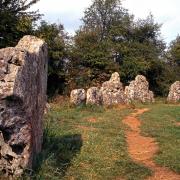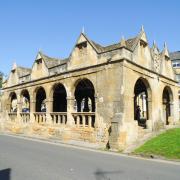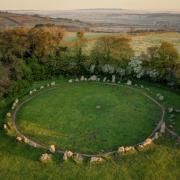There is something particularly magical about visiting prehistoric sites in autumn. Low raking sunshine and shadows lift ancient lumps, bumps and tumps into hyper-relief in the landscape; scatters of frost add ethereal crusts to the swell of long barrows or the ridges of Iron-Age hill forts. Those liminal moments when we stand where our ancestors stood, hovering between past and present, take on a special intensity.
People have settled in the Cotswolds for more than 6,000 years, interpreting and shaping the landscape, and with lots of local limestone suitable for building, the area is well endowed with visible, surviving Neolithic (c. 4,000-2,500BC) monuments.
Belas Knap Long Barrow is a prime example, on the modern-day Cotswold Way above Winchcombe and well worth a bracing uphill walk (coming from the town direction) to explore. Dating from circa 3,000BC, the brooding trapezoid mound conceals four burial chambers within, and excavations have identified skeletal remains of 37 people, including later Bronze-Age interments.
Styles of Neolithic tombs vary from region to region and Belas Knap is one of more than 100 of the Cotswold-Severn type: built of megaliths forming passageways and associated burial chambers that have then been covered over by earth to create an oval or elongated mound.
Much mystery surrounds the ‘false entrance’ at Belas Knap, formed by two standing stones and a lintel stone within a ‘horned’ forecourt: was it intended to divert attention from the real, side entrances to the burial chambers, which when closed and covered by earth would have been invisible from the outside? Was it a ‘spirit door’ to allow the dead to come and go, perhaps to partake of offerings brought by their descendants? Or was it simply to make the tomb look impressive, with burial rites or ceremonies taking place in the forecourt?

Like many other long barrow tombs, Belas Knap is prominently sited high in the hillside, speaking even now of respect for the ancient dead and the symbolic power of dramatic scenery. Channelling the authority of ancestors, barrows may have served as territorial markers over valley communities below.
Windmill Tump Long Barrow, southwest of Rodmarton, is another fine example of a Cotswold-Severn type with so-called false entrance and horned forecourt. Finds of Roman pottery and coins indicate the site was used for burials well after the Neolithic period.
Meanwhile Uley Long Barrow – aka Hetty Pegler’s Tump, after a 17th-century landowner – follows a transepted (cruciform) design with two pairs of chambers opening from a central passage. The site is reached along the signed footpath near the layby 3.5 miles north-east of Dursley on the B4066, and you can explore the barrow’s interior, so bring a torch!
Further along the B4066 in Coaley Peak Viewpoint, overlooking the Severn Valley, Nympsfield Long Barrow has its internal chambers revealed to the open air.

IRON-AGE RAMPARTS
Fancy atmospheric adventures on a larger scale? Iron-Age hill forts with their rippling ramparts make the most of naturally commanding positions along the Cotswold escarpment and high points with panoramic views.
What we call hill forts were not necessarily built as primarily military or defensive sites – archaeological evidence suggests a more diverse settlement use, and each has its own rich story.
A breezy ramble along the Cotswold Way – or a 4-mile circular walk from Uley – will take you to one of the finest: flat-topped, 32-acre Uley Bury Iron-Age hill fort 750ft up on a spur of the scarp was created by terracing a double line of ramparts in the hillside. Finds here have ranged from pottery to a gold coin of the Dobunni tribe.
Or explore the pathways of Crickley Hill, where evidence of habitation and violent encounters dates back to the Neolithic period. An Iron-Age fort was burned and abandoned in the 6th century BC – over 400 arrowheads discovered at its entrance indicate some sort of battle. People later lived on the hill until the 5th century AD.
In the southern Cotswolds above the village of Batheaston, Little Solsbury Hill was once occupied by wattle and daub huts within a univallate (single) rampart faced with drystone walls.
In the northern Cotswolds, Kemerton Camp hill fort atop Bredon Hill was the scene of a bloody battle circa AD33 (bodies of some 50 slaughtered men and boys were found around the entrance). There are also two smaller hill forts here, Elmley Castle and Conderton – the latter may originally have been a cattle compound that later became a village of round huts.
But to finish with a modern twist: the remnants of Iron-Age Kimsbury Hill Fort (Painswick Beacon) now have Painswick golf course built on top, presenting players with the unusual challenge of several holes fully or partly enclosed by ramparts of earth and stone.
STEP BACK IN TIME
Visit cotswoldsaonb.org.uk for self-guided routes featuring numerous Neolithic and Iron-Age sites around the Cotswolds, including:
Winchcombe to Belas Knap Long Barrow; 5.5 miles. Following parts of the Cotswold Way and including a brisk uphill section, this circular route takes in the enigmatic long barrow and offers fine views over Sudeley Castle on the way back down.
Crickley Hill (Walks on Wheels). Suitable for wheelchairs, mobility scooters and children’s buggies, this short country park trail features elevated vistas across the Severn Vale as you head to the top of the Iron-Age hill fort.
Little Solsbury Hill Circular (Bathscape); 3.3 miles. Climb to the top of the hill, once occupied as an Iron-Age hill fort and in modern times the inspiration for Peter Gabriel’s classic, Solsbury Hill – a chance to reprise “...Wind was blowing, time stood still...”
Further information on visiting
- Belas Knap, Hetty Pegler’s Tump, Nympsfield Long Barrow, Windmill Tump: english-heritage.org.uk
- Bredon Hill: discoverworcestershire.co.uk
- Crickley Hill: nationaltrust.org.uk / gloucestershirewildlifetrust.co.uk
- Kimsbury (Painswick Beacon), Little Solsbury Hill, Uley Bury: megalithic.co.uk
Images © David R. Abram, whose book, the Aerial Atlas of Ancient Britain, is available online at davidabram.co.uk, and in bookshops throughout the Cotswolds.



























